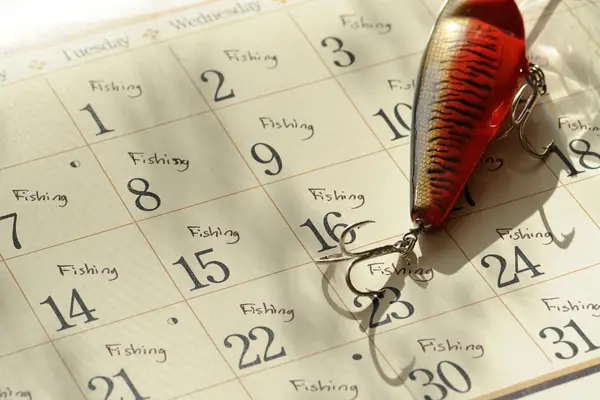Recently I have had a couple of questions asking about Solunar Calendars, are they a useful tool for predicting the best time to go trout fishing? In this article, I will share my thoughts and explain why I do not consider Solunar Calendars to be useful.
Solunar Calendars are not a useful tool for predicting the feeding time of fish. That is because other variables such as water temperature, food availability, and light levels are much more significant in determining when fish feed.
Variables such as water temperature, Food avaliability and light levels play a much greater role.
Many variables come into play to determine when and for how long a trout feeds. The three main variables are water temperature, time of day, and food availability. In the warmer months, trout often feed at dusk and dawn, but do they feed at that time of day due to the changes in light levels or the drop in water temperatures, or a combination of both? Food availability also plays a massive role, if a hatch occurs at midday, it is very likely trout will come out of hiding to take advantage of the abundance of food.
So, what do these have to do with the Solunar Calendar? Well, they are all factors that for the most part are independent of it. But in most cases, these three factors have a much greater influence on trout feeding behavior than the movement of the moon.
Sure the moon might be in the ideal position relative to the sun, but what if there is no insect activity and the water is freezing cold because it is 6 am on a winter morning? The trout are not going to feed. Likewise, the moon could be in a terrible position, but if the mayflies are swarming then the trout will likely get excited.
Solunar calendars are usually generalist and not species depedent.
Most solunar calendars I have seen are very general in nature. They try and predict the ‘best’ feeding time for all species of fish in one simple chart.
Anyone who has spent time fishing knows, that different fish have different feeding preferences. They do not all feed at the same time of day, nor in the same conditions. So a one size fits all answer can not be correct for all species of fish in all locations.
There is some evidence, that more fish frequent shallow water more during a new moon than a full moon. Maybe they feel safer under the protection of darkness. But that also means, during a full moon, there is more fish in deeper water. Fish move around.
So on a dark night, there might be more fish in the shallows. That is good news if you are fishing the margins, but that can just as easily mean harder fishing if targeting deep holes.
This is a trout fishing website. I will explain with trout as an example. Rainbow trout, are primarily visual feeders they prefer to feed during the day. They spot their food then eat it.
Brown trout, on the other hand, depend more on their lateral line to sense the vibration of prey. They also happen to be more nocturnal (but not always). No one rule fits all when it comes to fishing.
Let’s say it’s a full moon. The nights are brighter, so the Rainbow trout can more easily feed. They feel safer under the cover of darkness. But, that also means, by morning, the rainbows would have full bellies so will be less willing to feed. So someone fishing at lunchtime might find rainbows harder to catch during a full moon.
Brown trout on the other hand, always feed at night. So the full moon is not much of an advantage. It might even allow their prey to better avoid them. They might even be forced to feed more during the day. Making them, slightly easier to catch during the full moon.
Now, let’s assume the Brown trout share their lake with pike. Pike are visual hunters, they ambush trout so the full moon is perfect hunting time. The Brown trout, not wanting to be pike food might delay their feeding until the day when the Pike retreat to deeper water.
Some full moon, but the trout behave differently based on their environments. This is impossible to reflect in a simple Solunar calendar.

